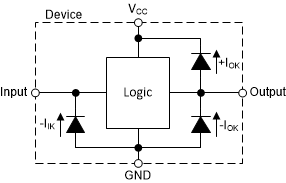SCLS741D November 2013 – May 2024 SN74LV1T32
PRODUCTION DATA
- 1
- 1 Features
- 2 Applications
- 3 Description
- 4 Related Products
- 5 Pin Configuration and Functions
- 6 Specifications
- 7 Parameter Measurement Information
- 8 Detailed Description
- 9 Application and Implementation
- 10Device and Documentation Support
- 11Revision History
- 12Mechanical, Packaging, and Orderable Information
8.3.1 Clamp Diode Structure
The outputs to this device have both positive and negative clamping diodes, and the inputs to this device have negative clamping diodes only as shown in Figure 8-1.
CAUTION: Voltages beyond
the values specified in the Absolute Maximum Ratings table can cause damage to the
device. The input and output voltage ratings may be exceeded if the input and output
clamp-current ratings are observed.
 Figure 8-1 Electrical Placement of Clamping
Diodes for Each Input and Output
Figure 8-1 Electrical Placement of Clamping
Diodes for Each Input and Output